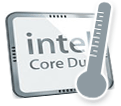Quick - How to measure temperatures correctly
1. Warming up and settings
Be in a room with normal ambient temperatures, around 20 °C. Place the computer on a flat table top. Power on the machine and give the components time to level off with the ambient temperature.
You should be conducting the measurements using the following practices:
- The MagSafe plugged in
- Optimization set to Better Performance in the Energy Saver panel
- Brightness turned to full
- Wireless and bluetooth turned on
2. Software
2.1 SpeedIt
Install SpeedIt by the Increw Team. Make sure to get the latest avaiable version.
2.2 Hardware Monitor
Install the graphical application to poll data from SpeedIt. Hardware Monitor will automatically detect if the extension is running in the background. The demo version allows you to read temperatures without restrictions.
2.3 (Optional) CoreDuoTemp
Simple interface that will show you three values; CPU temperatures, CPU usage and CPU frequency.
3. Start monitoring
Configure Hardware Monitor, set the Update Interval to 1 sec and add a new temperature history. Add a CPU temperature sensor and a S.M.A.R.T temperature sensor. Select the Window menu and Show History Windows.
4. Idle temperature
Quit all other applications and let the machine idle for 10 minutes. The CPU will throttle down while idle even when Better Performance is selected. You can watch this happen with CoreDuoTemp.
Try to simulate an average configuration of Mac OS X. This will avoid incorrect readings of the idle temperature.
After 10 minutes, wrtite down the current idle temperature shown in Hardware Monitor or CoreDuoTemp.
Note: If your temperature does not exceed 30 °C, you are probably affected by the AE18 bug. Read more here
5. Load temperature
Time to maximize the thermal heat output of the CPU. Open the Terminal application in the Utilities folder and execute the command below:
yes >/dev/null
This will make one CPU core work and therefore you need to open a new Terminal window by selecting File -> New and executing the command again:
yes >/dev/null
Let the machine run for 10 minutes to stabilize the load temperature. After 10 minutes write down the current load temperature shown in Hardware Monitor or CoreDuoTemp.
Note: We're not looking for the peak temperature but the average temperature after the fans has kicked in and cooled the machine while under heavy load.
6. Hard drive temperature
Immediately after you've finished the load temperature recording, you can write down the hard drive temperature reported by the S.M.A.R.T sensor inside the hard drive.
7. Submit information
You should now have the idle, load and hard drive temperatures ready. Go to the submit form and enter this information along with the computer spesifications. Make sure to leave a comment.
Thanks for the effort!
|

